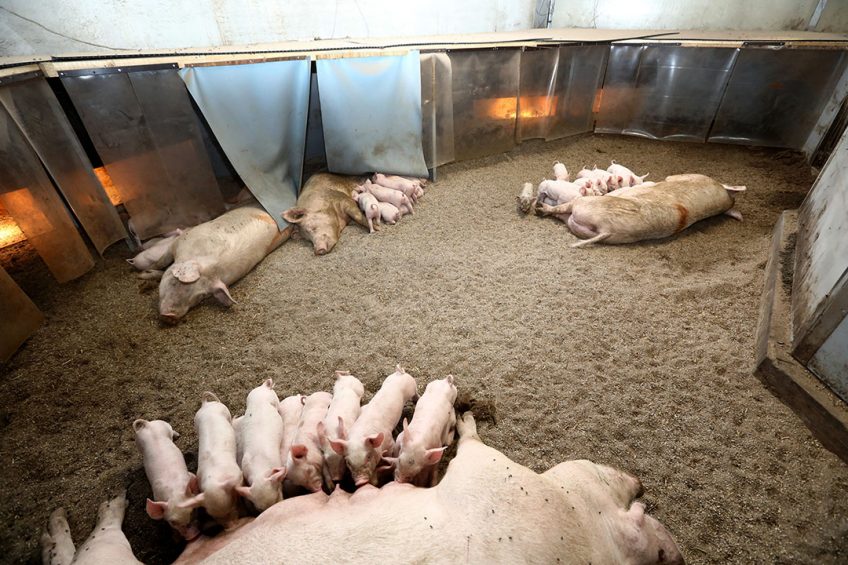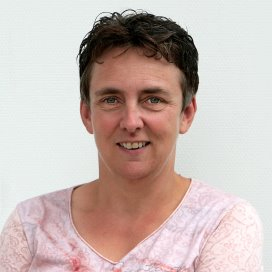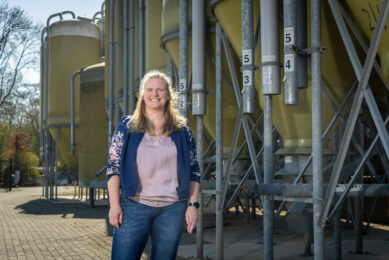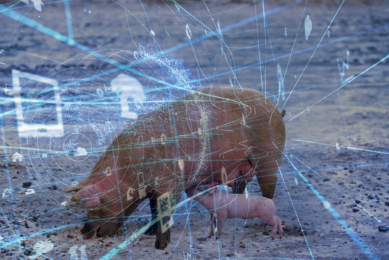Welfare and environment key in innovative barn

A modular barn with many welfare aspects – that, in short, is the concept of “Het Familievarken” (The Family Pig). Built on the premises of pig farmer Ivo Bekkers, in Venhorst, the Netherlands, the barn has a special feature: pig toilets.
Above the finisher pen, the feed mount starts to move, and the pigs search the ground for chunks. Ivo Bekkers says, “In the beginning, the sows followed the mount through the barn. They have figured out now that enough falls down in the 20 minutes the system is moving, so they are much calmer.”
‘The Familievarken’ innovation barn was built in 2019 behind Bekkers’ finisher barns. Innovators Tjacko Sijpkens and Frank Wind are the driving forces behind the initiative that searches for a different style of housing. They have cooperated with Wageningen University & Research, Hypor, Coppens Diervoeders, as well as construction companies and equipment manufacturers.
Name: Ivo Bekkers, age 37.
Location: Venhorst, the Netherlands.
Farm: The Bekkers farm is mainly a finisher farm, with 4,000 finisher pigs at 2 locations. The Familievarken initiative is a closed 48-sow farm section behind one of these locations. In that closed section, Bekkers achieves 15 piglets born/sow and 12.8 weaned piglets/sow. The Familievarken finishers achieve growth of 950g/day. In total, 5 ppm ammonia emission is measured.
The barn looks like an oversized yurt (nomad tent, ed.), with plenty of extra room for the pigs. Building costs, however, are not much higher than those for a traditional barn. Wind says, “There is no pit underneath the barn. The toilets dispose of the day’s manure immediately. The modular superstructure is cheap. The aim is to require the usual investment per animal place, the same as in a traditional barn. We have definitely come close.”
For the next phase in the quest for the ideal barn, Familievarken is looking for other farms that would like to keep a selection of their pigs this way. Wind explains, “Our aim is 50 to 60 farms over the course of ten years, depending on their size, of course. The barn is modular, which means that there would be 10 adjacent units for a farm that keeps 480 sows.”

In Dutch politics, recently there has been a little storm as one politician called for the downsizing of the country’s pig production volume by 50% for environmental reasons. Wind responds by saying, “The Netherlands is in the absolute top of pig countries worldwide. That makes us proud. So, we do not wish to halve, but rather innovate further and earn a fair price.”

Natural behaviour first
In the barn, animal welfare and natural needs are both well thought out. The pigs have twice as much room than is legally required. Weaned piglets have even more room as they remain in the farrowing pens after weaning, until they are ready for slaughter. The barn is divided into two rings. Dry and gestating sows are housed in the inner pens. The outer pens are reserved for farrowing. At first, the pens used to be covered in a layer of black sand, but that sand did not drain as much liquid as necessary. Now there is a layer of dryer drainage sand in the pens.

The dry and gestating sows are housed in one group with nipple drinkers and manure pit in the middle. Despite the available space, a number of animals huddle together. At the other side, the largest sow in the group forcefully chases away one of the smaller sows. She drops down a few metres away, after having drawn a large furrow in the sand with her nose.
Wind says, “Great how they behave, isn’t it? Rank still applies like it does in the traditional barns, but here they have ample opportunity to root and dig.”
Together, the four farrowing sows have 53 piglets. As soon as the first sow has lain down, all youngsters dash to their own mothers. The first group of farrowing sows was split up into one group with a weaning age of 5 weeks and another of six weeks, to see what worked best. Bekkers says, “We saw little difference in weaning weight. Weaning takes place more gradually at an older age, because the piglets join in with feeding. We were afraid at first that the sows would lose weight, but this did not happen.”

The first group of finishers has been slaughtered. The animals achieved 950–1,000 grammes growth per day. Muscular development is a challenge in the finishing period. Because the animals move through the sand, they have ample muscles. Even at a week old, the piglets already have solid shoulders and hams.
Use of the pig toilet: a challenge
From an environmental point of view, the pig toilet should ensure a reduction of ammonia emission. Bekkers says, “First measurements have shown that we have 5 ppm ammonia now in there. We try to separate manure at the source, based on behaviour. This can lead to an 85% reduction. In order to reach these last per cents, we would have to install an air scrubber.”

The pig toilet makes sure that the odour of manure in the barn is reduced almost to zero. It smells like pig, but far less penetrating than in traditional barns. This pig toilet is the biggest challenge, according to Bekkers and Wind. The pigs do well in the spacious pens, but potty training them is not easy. Pointing at the dark spot alongside the wall, Bekkers says, “We are trying to find out how we can get them to do their business in one spot only. The sows’ manure mostly finds the right spot, but they still urinate too much in the feeding and lying space. The finishers also have a wet spot in their lying space suddenly. It is probably the climate. We have not found out yet exactly what causes it.”












